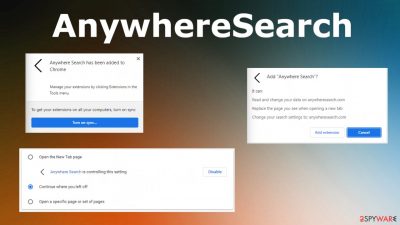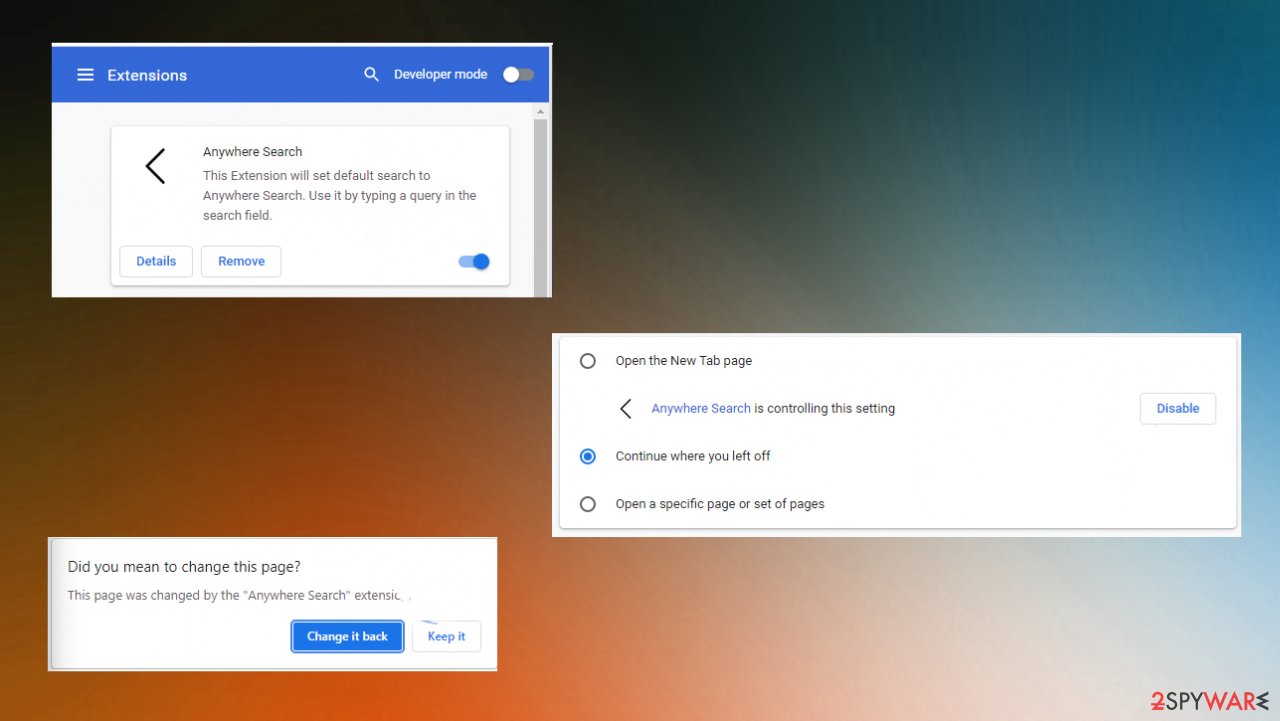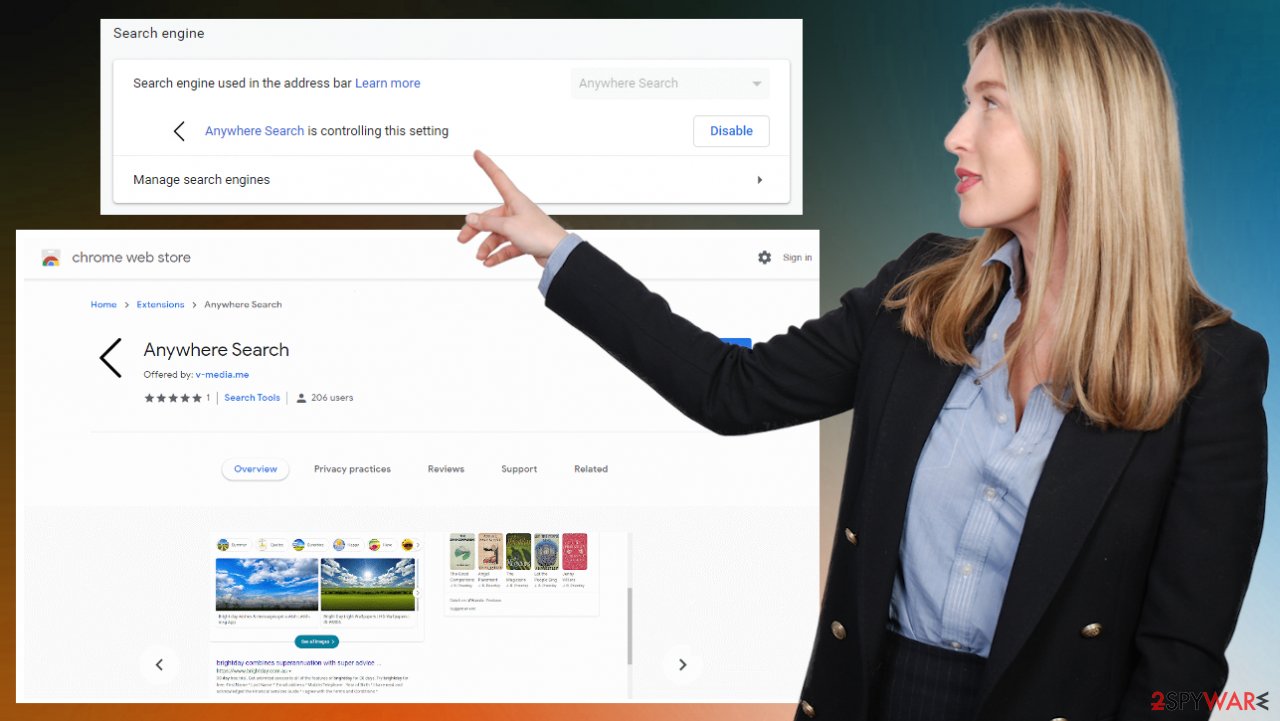AnywhereSearch browser hijacker (spam) - Chrome, Firefox, IE, Edge
AnywhereSearch browser hijacker Removal Guide
What is AnywhereSearch browser hijacker?
AnywhereSearch is the search program that falls to the category of a browser hijacker for changes caused to web browsing tools

AnywhereSearch is the potentially unwanted program or the specific type of browser-based threat. The app aims to expose users to third-party material and other related content, so the associates of this browser hijacker can collect views and visits on their sites. The program is designed to redirect users, so the default search engine, new, tab, new window, and other common browser settings get altered immediately upon the infiltration.
There are various misleading platforms and services that get used to distribute browser-based apps like this one. You might receive the PUA when allowing pre-packed bundles to get downloaded on the system. Unfortunately, in most cases, the initial installation of the potentially unwanted program happens while the user is browsing online and clicks on the insecure content or installs the dangerous material from the shady site or platform.
This particular manipulator is called an AnywhereSearch browser hijacker because it controls the browsing material and results of the search engine that the user relies on. Startpage, search scopes, new tabs all show altered material, so browsing for things online becomes advertising campaigns with all the redirects, banners, pop-ups, and hyperlinks on the list of results. This is not a virus, but it is recommended to get the app removed as soon as possible.
| Name | AnywhereSearch |
|---|---|
| Type | Browser hijacker, extension |
| Category | Potentially unwanted program[1] |
| Affects | The common browsers like Google Chrome, Mozilla Firefox, Internet Explorer, or even Safari |
| Distribution | Freeware is the main issue when it comes to PUP distribution because installations of the programs can lead to unwanted app downloads |
| Damage | These services expose users to unwanted or possibly malicious material related to data tracking and security issues. PUP developer is not responsible for the dangerous material you may end up visiting due to redirects |
| Removal | The best PUP removal – antivirus tools that scan the machine fully |
| Repair | System can get easily affected or files damaged, so repair those issues with proper app like FortectIntego |
Anywhere Search is a browser hijacker that changes some of the browsers' settings and alters the default homepage, search engine to anywheresearch.com, promotes other pages and search sites. It also adds in “Managed by your organization” feature, which means you have been targeted with this malicious application without even knowing it, and more settings could have been changed behind your back.[2]
This can sometimes happen if someone installs applications they do not mean or intend on installing from unknown sources. Keep an eye out for these types, especially when browsing online with devices connected directly into the free and public network – because chances are there are attackers or PUP distributors around.
Indicators that tell about possible PUP infection
Many people are unfamiliar with browser hijackers and how they can affect your browsing experience. Anywhere Search is a specific type of unwanted program that changes the homepage on an infected computer as well as changing what search engine you use by default. This activity often leads users down an online rabbit hole where clicking ads will lead them even deeper into the dark and dangerous content.

Some individuals do not know about these types of programs because there may not always be visible warning signs or symptoms telling that the computer has been compromised without user consent. However, it does not take much to notice issues with speed and device performance. Those can be the first indicators that there is a cyber intruder running. Experts[3] note that it is crucial to remove the PUP as soon as possible.
The intruder is mainly installed on Google Chrome and is pushed for the users of this browser. But AnywhereSearch browser hijacker can affect other browsing tools and machines. This is the problem that even occurs on mobile phones. The best way to fight the PUP is with anti-malware tools.
Apps like SpyHunter 5Combo Cleaner or Malwarebytes can clear intruders from the machine and ensure the security of the machine. You may not be aware that the PUP is only a minor issue, so checking the system thoroughly is recommended. Do not forget to alter those major settings manually too.
Delete malicious extensions from Google Chrome:
- Open Google Chrome, click on the Menu (three vertical dots at the top-right corner) and select More tools > Extensions.
- In the newly opened window, you will see all the installed extensions. Uninstall all the suspicious plugins that might be related to the unwanted program by clicking Remove.
![Remove extensions from Chrome Remove extensions from Chrome]()
Clear cache and web data from Chrome:
- Click on Menu and pick Settings.
- Under Privacy and security, select Clear browsing data.
- Select Browsing history, Cookies and other site data, as well as Cached images and files.
- Click Clear data.
![Clear cache and web data from Chrome Clear cache and web data from Chrome]()
Change your homepage:
- Click menu and choose Settings.
- Look for a suspicious site in the On startup section.
- Click on Open a specific or set of pages and click on three dots to find the Remove option.
Remove dangerous extensions:
- Open Mozilla Firefox browser and click on the Menu (three horizontal lines at the top-right of the window).
- Select Add-ons.
- In here, select unwanted plugin and click Remove.
![Remove extensions from Firefox Remove extensions from Firefox]()
Reset the homepage:
- Click three horizontal lines at the top right corner to open the menu.
- Choose Options.
- Under Home options, enter your preferred site that will open every time you newly open the Mozilla Firefox.
A full reset of these browsers might be required if none of the methods help. For that, you should check the full removal guide below. AnywhereSearch potentially unwanted application can be running for a while on the machine, so try to check the machine thoroughly so the system gets cleared.
Eliminating the PUP from the machine
The particular behavior f these browser-based threats is mainly controlled by the potentially unwanted program that runs in the background. Commonly, such intruders spread around and affect the machine significantly before these symptoms occur for the user to notice. You might know when issues started because you installed the app AnywhereSearch browser hijacker
These programs mainly appear due to poor users' behavior while browsing the internet. Freeware installations and deceptive online content lead to issues with the machine and cyber infections because people are not paying attention to important details. These intruders that are affecting browsers' performance and internet speed mainly get installed alongside other programs.

You are the one that allowed the AnywhereSearch browser hijacker to get launched and installed. If you recently downloaded a program or tool on the computer, you should think about the source you used and the freeware installation option that was selected. if you go for Advanced or Custom options, you should be able to avoid these instances when PUPs get installed alongside freeware.
Choosing recommended or quick options or relying on torrent platforms results in PUA infiltrations, downloads of different apps, and even malware. Make sure to clean the machine thoroughly, so these symptoms stop. The program can also be distributed on different sites, promotional platforms. Always read reviews before downloading things from random pages and never trust promotional ads.
Instructions for Windows 10/8 machines:
- Enter Control Panel into Windows search box and hit Enter or click on the search result.
- Under Programs, select Uninstall a program.
![Uninstall from Windows 1 Uninstall from Windows 1]()
- From the list, find the entry of the suspicious program.
- Right-click on the application and select Uninstall.
- If User Account Control shows up, click Yes.
- Wait till uninstallation process is complete and click OK.
![Uninstall from Windows 2 Uninstall from Windows 2]()
If you are Windows 7/XP user, proceed with the following instructions:
- Click on Windows Start > Control Panel located on the right pane (if you are Windows XP user, click on Add/Remove Programs).
- In Control Panel, select Programs > Uninstall a program.
![Uninstall from Windows 7/XP Uninstall from Windows 7/XP]()
- Pick the unwanted application by clicking on it once.
- At the top, click Uninstall/Change.
- In the confirmation prompt, pick Yes.
- Click OK once the removal process is finished.
The particular program that alters the homepage search engine settings, and makes the new tab its own site should be terminated as soon as possible. AnywhereSearch browser hijacker is not only annoying and intrusive with all those redirects and search hijacking, but it is a threat that can lead to serious system damage.
You may remove virus damage with a help of FortectIntego. SpyHunter 5Combo Cleaner and Malwarebytes are recommended to detect potentially unwanted programs and viruses with all their files and registry entries that are related to them.
Getting rid of AnywhereSearch browser hijacker. Follow these steps
Delete from macOS
Remove items from Applications folder:
- From the menu bar, select Go > Applications.
- In the Applications folder, look for all related entries.
- Click on the app and drag it to Trash (or right-click and pick Move to Trash)

To fully remove an unwanted app, you need to access Application Support, LaunchAgents, and LaunchDaemons folders and delete relevant files:
- Select Go > Go to Folder.
- Enter /Library/Application Support and click Go or press Enter.
- In the Application Support folder, look for any dubious entries and then delete them.
- Now enter /Library/LaunchAgents and /Library/LaunchDaemons folders the same way and terminate all the related .plist files.

Remove from Microsoft Edge
Delete unwanted extensions from MS Edge:
- Select Menu (three horizontal dots at the top-right of the browser window) and pick Extensions.
- From the list, pick the extension and click on the Gear icon.
- Click on Uninstall at the bottom.

Clear cookies and other browser data:
- Click on the Menu (three horizontal dots at the top-right of the browser window) and select Privacy & security.
- Under Clear browsing data, pick Choose what to clear.
- Select everything (apart from passwords, although you might want to include Media licenses as well, if applicable) and click on Clear.

Restore new tab and homepage settings:
- Click the menu icon and choose Settings.
- Then find On startup section.
- Click Disable if you found any suspicious domain.
Reset MS Edge if the above steps did not work:
- Press on Ctrl + Shift + Esc to open Task Manager.
- Click on More details arrow at the bottom of the window.
- Select Details tab.
- Now scroll down and locate every entry with Microsoft Edge name in it. Right-click on each of them and select End Task to stop MS Edge from running.

If this solution failed to help you, you need to use an advanced Edge reset method. Note that you need to backup your data before proceeding.
- Find the following folder on your computer: C:\\Users\\%username%\\AppData\\Local\\Packages\\Microsoft.MicrosoftEdge_8wekyb3d8bbwe.
- Press Ctrl + A on your keyboard to select all folders.
- Right-click on them and pick Delete

- Now right-click on the Start button and pick Windows PowerShell (Admin).
- When the new window opens, copy and paste the following command, and then press Enter:
Get-AppXPackage -AllUsers -Name Microsoft.MicrosoftEdge | Foreach {Add-AppxPackage -DisableDevelopmentMode -Register “$($_.InstallLocation)\\AppXManifest.xml” -Verbose

Instructions for Chromium-based Edge
Delete extensions from MS Edge (Chromium):
- Open Edge and click select Settings > Extensions.
- Delete unwanted extensions by clicking Remove.

Clear cache and site data:
- Click on Menu and go to Settings.
- Select Privacy, search and services.
- Under Clear browsing data, pick Choose what to clear.
- Under Time range, pick All time.
- Select Clear now.

Reset Chromium-based MS Edge:
- Click on Menu and select Settings.
- On the left side, pick Reset settings.
- Select Restore settings to their default values.
- Confirm with Reset.

Remove from Mozilla Firefox (FF)
Remove dangerous extensions:
- Open Mozilla Firefox browser and click on the Menu (three horizontal lines at the top-right of the window).
- Select Add-ons.
- In here, select unwanted plugin and click Remove.

Reset the homepage:
- Click three horizontal lines at the top right corner to open the menu.
- Choose Options.
- Under Home options, enter your preferred site that will open every time you newly open the Mozilla Firefox.
Clear cookies and site data:
- Click Menu and pick Settings.
- Go to Privacy & Security section.
- Scroll down to locate Cookies and Site Data.
- Click on Clear Data…
- Select Cookies and Site Data, as well as Cached Web Content and press Clear.

Reset Mozilla Firefox
If clearing the browser as explained above did not help, reset Mozilla Firefox:
- Open Mozilla Firefox browser and click the Menu.
- Go to Help and then choose Troubleshooting Information.

- Under Give Firefox a tune up section, click on Refresh Firefox…
- Once the pop-up shows up, confirm the action by pressing on Refresh Firefox.

Remove from Google Chrome
Delete malicious extensions from Google Chrome:
- Open Google Chrome, click on the Menu (three vertical dots at the top-right corner) and select More tools > Extensions.
- In the newly opened window, you will see all the installed extensions. Uninstall all the suspicious plugins that might be related to the unwanted program by clicking Remove.

Clear cache and web data from Chrome:
- Click on Menu and pick Settings.
- Under Privacy and security, select Clear browsing data.
- Select Browsing history, Cookies and other site data, as well as Cached images and files.
- Click Clear data.

Change your homepage:
- Click menu and choose Settings.
- Look for a suspicious site in the On startup section.
- Click on Open a specific or set of pages and click on three dots to find the Remove option.
Reset Google Chrome:
If the previous methods did not help you, reset Google Chrome to eliminate all the unwanted components:
- Click on Menu and select Settings.
- In the Settings, scroll down and click Advanced.
- Scroll down and locate Reset and clean up section.
- Now click Restore settings to their original defaults.
- Confirm with Reset settings.

Delete from Safari
Remove unwanted extensions from Safari:
- Click Safari > Preferences…
- In the new window, pick Extensions.
- Select the unwanted extension and select Uninstall.

Clear cookies and other website data from Safari:
- Click Safari > Clear History…
- From the drop-down menu under Clear, pick all history.
- Confirm with Clear History.

Reset Safari if the above-mentioned steps did not help you:
- Click Safari > Preferences…
- Go to Advanced tab.
- Tick the Show Develop menu in menu bar.
- From the menu bar, click Develop, and then select Empty Caches.

After uninstalling this potentially unwanted program (PUP) and fixing each of your web browsers, we recommend you to scan your PC system with a reputable anti-spyware. This will help you to get rid of AnywhereSearch browser hijacker registry traces and will also identify related parasites or possible malware infections on your computer. For that you can use our top-rated malware remover: FortectIntego, SpyHunter 5Combo Cleaner or Malwarebytes.
How to prevent from getting browser hijacker
Access your website securely from any location
When you work on the domain, site, blog, or different project that requires constant management, content creation, or coding, you may need to connect to the server and content management service more often. The best solution for creating a tighter network could be a dedicated/fixed IP address.
If you make your IP address static and set to your device, you can connect to the CMS from any location and do not create any additional issues for the server or network manager that needs to monitor connections and activities. VPN software providers like Private Internet Access can help you with such settings and offer the option to control the online reputation and manage projects easily from any part of the world.
Recover files after data-affecting malware attacks
While much of the data can be accidentally deleted due to various reasons, malware is one of the main culprits that can cause loss of pictures, documents, videos, and other important files. More serious malware infections lead to significant data loss when your documents, system files, and images get encrypted. In particular, ransomware is is a type of malware that focuses on such functions, so your files become useless without an ability to access them.
Even though there is little to no possibility to recover after file-locking threats, some applications have features for data recovery in the system. In some cases, Data Recovery Pro can also help to recover at least some portion of your data after data-locking virus infection or general cyber infection.
- ^ Potentially unwanted program. Wikipedia. The free encyclopedia.
- ^ Chirs Hoffman. Why does Chrome say managed by your organization?. Howtogeek. IT and security news reports.
- ^ Lesvirus. Lesvirus. Spyware news.























